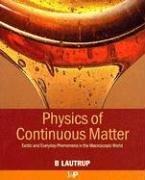| Listing 1 - 10 of 2030 | << page >> |
Sort by
|

ISBN: 0750307528 9780750307529 Year: 2005 Publisher: Bristol IOP
Abstract | Keywords | Export | Availability | Bookmark
 Loading...
Loading...Choose an application
- Reference Manager
- EndNote
- RefWorks (Direct export to RefWorks)
With equal emphasis on intuition and formalism, this text provides a unified, comprehensive, and coherent introduction to continuum physics that requires only some Newtonian mechanics and modest mathematical prerequisites that are further developed in the text. Based on the author's years of teaching the subject, the book is highly structured and useful on several tracks: as the main text for a course on continuum physics or as the foundation for courses on more specialized areas, such as solid mechanics, fluid mechanics, geophysics, and astrophysics. It contains all the usual features of a textbook: plenty of illustrations, problem sets with solutions, and an introduction to numerical simulations. OTIs OTI 1 IP177
Physics --- Field theory (Physics) --- Field theory (Physics).
Book
ISBN: 3778502301 9783778502303 Year: 1971 Publisher: Berlin : Verlag Technik VEB,
Abstract | Keywords | Export | Availability | Bookmark
 Loading...
Loading...Choose an application
- Reference Manager
- EndNote
- RefWorks (Direct export to RefWorks)
Book
ISBN: 3031404335 3031404327 Year: 2023 Publisher: Cham, Switzerland : Springer,
Abstract | Keywords | Export | Availability | Bookmark
 Loading...
Loading...Choose an application
- Reference Manager
- EndNote
- RefWorks (Direct export to RefWorks)
Book
ISBN: 9780199547586 0199547580 Year: 2011 Publisher: Oxford: Oxford university press,
Abstract | Keywords | Export | Availability | Bookmark
 Loading...
Loading...Choose an application
- Reference Manager
- EndNote
- RefWorks (Direct export to RefWorks)
Book
Year: 2002 Publisher: Cambridge, United Kingdom : Cambridge University Press,
Abstract | Keywords | Export | Availability | Bookmark
 Loading...
Loading...Choose an application
- Reference Manager
- EndNote
- RefWorks (Direct export to RefWorks)
This 2002 book discusses the classical foundations of field theory, using the language of variational methods and covariance. It is an ideal supplementary text for courses on elementary field theory, group theory and dynamical systems, and a valuable reference for researchers. It has been reissued as an Open Access publication on Cambridge Core.
Book
ISBN: 008017034X Year: 1973 Publisher: Oxford Pergamon
Abstract | Keywords | Export | Availability | Bookmark
 Loading...
Loading...Choose an application
- Reference Manager
- EndNote
- RefWorks (Direct export to RefWorks)
Book
Year: 2002 Publisher: Cambridge, United Kingdom : Cambridge University Press,
Abstract | Keywords | Export | Availability | Bookmark
 Loading...
Loading...Choose an application
- Reference Manager
- EndNote
- RefWorks (Direct export to RefWorks)
This 2002 book discusses the classical foundations of field theory, using the language of variational methods and covariance. It is an ideal supplementary text for courses on elementary field theory, group theory and dynamical systems, and a valuable reference for researchers. It has been reissued as an Open Access publication on Cambridge Core.
Book
ISBN: 1608051951 9781608051953 Year: 2011 Publisher: [Place of publication not identified] Bentham Science Publishers
Abstract | Keywords | Export | Availability | Bookmark
 Loading...
Loading...Choose an application
- Reference Manager
- EndNote
- RefWorks (Direct export to RefWorks)
Classical field theory is employed by physicists to describe a wide variety of physical phenomena. These include electromagnetism, fluid dynamics, gravitation and quantum mechanics. The central entity of field theory is the field which is usually a multi component function of space and time. Those multi component functions are usually grouped together as vector fields as in the case in electromagnetic theory and fluid dynamics, in other cases they are grouped as tensors as in theories of gravitation and yet in other cases they are grouped as complex functions as in the case of quantum mechanic
Book
Year: 1989 Publisher: Cambridge Melbourne Sydney Cambridge Univeristy Press
Abstract | Keywords | Export | Availability | Bookmark
 Loading...
Loading...Choose an application
- Reference Manager
- EndNote
- RefWorks (Direct export to RefWorks)
Book
Abstract | Keywords | Export | Availability | Bookmark
 Loading...
Loading...Choose an application
- Reference Manager
- EndNote
- RefWorks (Direct export to RefWorks)
| Listing 1 - 10 of 2030 | << page >> |
Sort by
|

 Search
Search Feedback
Feedback About UniCat
About UniCat  Help
Help News
News